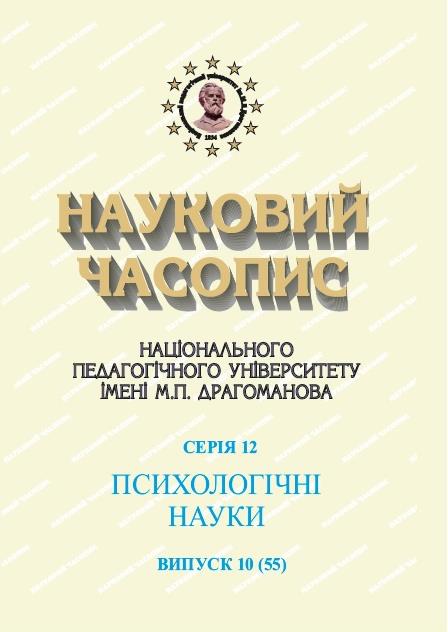PSYCHOLOGICAL FEATURES OF EMOTION REGULATION LITERATERALLY GIFTED HIGH SCHOOL STUDENTS
DOI:
https://doi.org/10.31392/NPU-nc.series12.2020.10(55).02Keywords:
emotional sphere, regulation of emotions, alexithymia, empathy, empathy, high school studentsAbstract
The article is devoted to the analysis of emotion regulation of high school students engaged in literary activity. The modern views on emotion regulation and ways and possibilities of effective emotional regulation are analyzed. Psychological difficulties that arise in schoolchildren with the regulation of their emotional state can be explained by such a psychological phenomenon as alexithymia, and the restraining factor for its development is empathy. Early youth is characterized as a favorable period for the development of empathy. The empathy development in early adolescence enables literary gifted students to express their highest empathy through literary creativity, and it is a resource for the regulation of emotions and for the prevention of alexithymia at this age. The article reveals the essence of such psychological concepts as: “emotional sphere”, “emotional regulation”, “alexithymia”, “empathy”, “empathetic behavior”. Diagnostic possibilities of methods of studying cognitive-emotional regulation, alexithymia, and empathy in early adolescence are analyzed. The results of the empirical study of the features of the development of high school students' empathy (its forms and levels of development) are described. It has been empirically established, that the level of empathy development in students who are involved in literary activities is higher than that level of average students. The predominant forms of empathic response in literary creative students are – “Real promotion not to the detriment of self” and “Altruism”, and in ordinary students – “Real promotion not to the detriment of self”, “Altruism”, “Indifference” and “Inner assistance”. Early youth (both literary and non-literary) have low levels of alexithymia, and they demonstrate a wide range of use of both adaptive and non-adaptive coping strategies for emotion regulation.
A greater number of empathic correlates of cognitive strategies of emotional regulation have been identified in literary-creative students compared to average students.
References
- Ageenkova,K., & Larionov, P.M. (2018). Novye vozmozhnosti issledovanija zhiznennogo scenarija v processe psihologicheskogo konsul'tirovanija [New possibilities of life scenario research in the process of psychological counseling]. Dialog – Dialogue, 3(50), 18-31. Retrieved from https://www.researchgate.net/publication/336304703 [in Russian]
- Brel',Ju. (2018). Aleksitimija v strukture «prakticheski zdorovoj» lichnosti [Аlexithymia in the structure of “apparently healthy” personality]. Sibirskij psihologicheskij zhurnal – Siberian journal of psychology, 67, 89-101. https://doi.org/10.17223/17267080/67/7 [in Russian]
- Vygotskij, L.S. (2002). Psihologija [Psychology]. Moskva : JeKSMO-Press [in Russian]
- Gaus,V., Pronenko, E.A., & Vasil'eva, O.S. (2019). Misheni psihologicheskoj raboty s ljud'mi, imejushhimi vysokij uroven' aleksitimii [Targets of psychological work for high alexithymia people]. Vestnik Rossijskogo universiteta druzhby narodov. Serija: Psihologija i pedagogika – RUDN Journal of Psychology and Pedagogics, 16(1), 55-70. https://doi.org/10.22363/2313-1683-2019-16-1-55-70 [in Russian]
- Esin,R., Gorobec, E.A., & Hajrullin, I.H. (2018). Aleksitimija u podrostkov s golovnoj bol'ju naprjazhenija [Diagnosis of alexithymia in adolescents with tension-type headache]. Nevrologicheskij vestnik – Neurological bulletin, 4, 40-43. Retrieved from https://psychiatr.ru/news/916?page=2 [in Russian].
- Zhuravlova,L. (2010). Diahnostyka empatii ta yii form u pidlitkovomu ta yunatskomu vitsi [Diagnosis of empathy and its forms in adolescence and adolescence]. Naukovyi chasopys NPU imeni M.P. Drahomanova. Seriia Psykholohichni nauky – Scientific journal of National Pedagogical Dragomanov University. Series 12. Psychological Sciences, 31(55), 154-161 [in Ukrainian].
- Zhuravlova,L.P. (2009). Vikova dynamika empatii v period doroslishannia [Тhe empathy's age-related dynamics in the period of adulthood]. Visnyk Dnipropetrovskoho universytetu. Seriia «Pedahohika i psykholohiia» – Dnipropetrovsk University Bulletin. Psychology Series, 15(9/1), 68-75. https://doi.org/10.15421/100910 [in Ukrainian].
- Izard, К. (1980). Jemocii cheloveka [Human emotions]. Per. s angl. Moskva : Izd-vo Mosk. un-ta. [in Russian].
- Il'in,P. (2013). Jemocii i chuvstva [Emotions and feelings]. (2-e izd.). Sankt-Peterburh : Piter [in Russian].
- Kolomiiets,T. (2016). Rozvytok empatiinoi mizhosobystisnoi vzaiemodii v yunatskomu vitsi [Development of еmpathic іnterpersonal іnteraction in аdolescence]. Nauka i osvita – Science and education, 9, 77-84. https://doi.org/10.24195/2414-4665-2016-9-15 [in Ukrainian].
- Moskacheva,A., Holmogorova, A.B., & Garanjan, N.G. (2014). Aleksitimija i sposobnost' k jempatii [Аlexithymia and empathy]. Konsul'tativnaja psihologija i psihoterapija – Counseling Psychology and Psychotherapy, 22(4), 98-114. https://doi.org/10.17759/cpp [in Russian].
- Rasskazova,I., Leonova, A.B., & Pluzhnikov, I.V. (2011). Razrabotka russkojazychnoj versii oprosnika kognitivnoj reguljacii jemocij [Russian version of Cognitive Emotion Regulation Questionnaire]. Vestnik Moskovskogo universiteta. Serija 14. Psihologija – Moscow University Psychology Bulletin, 4, 161-179. Retrieved from http://msupsyj.ru/articles/detail.php?article=2864 [in Russian].
- Artino,R. (2011). Regulation of Emotion. In S. Goldstein & J.A. Naglieri (Eds.) Encyclopedia of Child Behavior and Development. Springer: Boston, MA. https://doi.org/10.1007/978-0-387-79061-9
- Chen,, Xu,T., & Jing, J. (2011). Alexithymia and emotional regulation: A cluster analytical approach. BMC Psychiatry, 11(33). https://doi.org/10.1186/1471-244X-11-33
- Contardi,, Imperatori,C., & Penzo, I. (2016). The Association among Difficulties in Emotion Regulation, Hostility, and Empathy in a Sample of Young Italian Adults. Frontiers in Psychology. https://doi.org/10.3389/fpsyg.2016.01068
- Rieffe,, Oosterveld, P., & Meerum Terwogt, M. (2006). An alexithymia questionnaire for children: Factorial and concurrent validation results. Personality and Individual Differences, 40, 123-133. https://doi.org/10.1016/j.paid.2005.05.013
- Stavrova, O., & Meckel, A. (2017). Perceiving emotion in non-social targets: The effect of trait empathy on emotional contagion through art. Motiv Emot, 41, 492-509. https://org/10.1007/s11031-017-9619-5
- Vikan, (2017). Emotion Regulation. In: A Fast Road to the Study of Emotions (p. 57-62). Springer: Cham. https://doi.org/10.1007/978-3-319-52313-2_8

